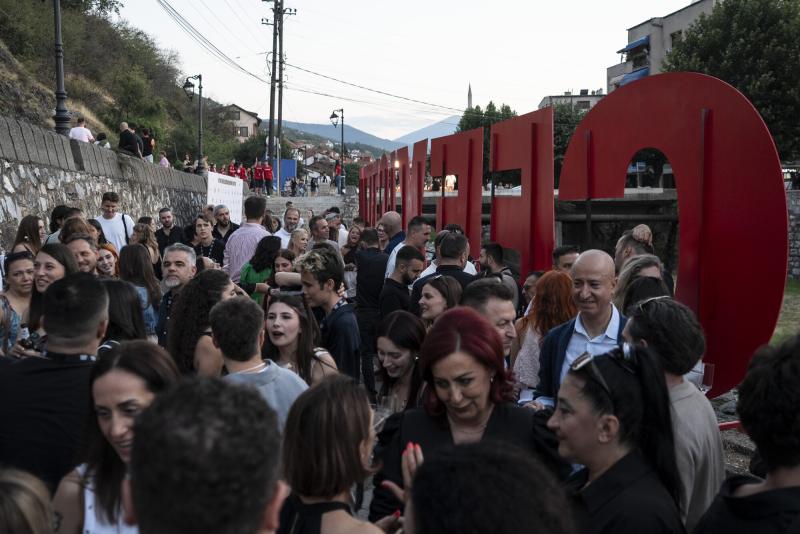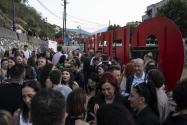Kontakt Collection at DokuFest
/4
Sometimes, when writing, I find myself confronting an old conflict: the text rarely follows my intentions, instead taking on a life of its own. To do justice to this selection of films¹, I let my notes move in free associations, coupling words with stills, slips, fragments. Reading these visual elements, or as Barthes would call them, “the subproduct of the film,” became a method of encountering these artworks. Silhouettes that resist the montage, I wrote for Hans Scheirl’s “At This Speed Hairs are Dashing.” Haunting signs for the other film, “Jocasta Emerges.” There are no speaking subjects in either of these experimental shorts, only a flow of images. These films reflect how, back in the 80s, Scheirl positioned filmmaking as both political and experimental, built on fragmentation and images that slip into one another.
In dialogue with this interrogation of the body and social structures, Mladen Stilinović’s “Walls, Coats, Shadows” examines political and social uniformity. Here, the body and its clothing, shot as mundane objects in relation to their spaces, become a conceptual critique of control inscribed in everyday life. In Rancièrean terms², these works politicize perception itself, rendering the hidden frames of conformity, identity, and gender legible and open to reflection.
Fantastical “Albanian Stories” emerge from the imagination of Adrian Paci’s daughter, a storyteller who won’t narrow her horizons as she tells tales of cats, pigs, and dark forces. Unlike in Želimir Žilnik’s “Inventory,” her words unfold freely, untouched by the weight of Italian exile felt by her father in 1997. Žilnik’s camera, by contrast, is deliberate, capturing the realities of guest workers in 1970s Germany. Each worker takes around ten seconds to describe their living situation: “Good.” “Not good.” This motivated shot in a shared building corridor heightens their shyness, with the act of grasping a handrail serving as a signifier of their uncertain present and future.
I continued writing: life is in the background. In “Glimpse,” Artur Żmijewski turns his 16mm camera to the faces, bodies, and spaces of emigrants in Berlin, Calais, Grand Synthe near Dunkerque, and Paris. Tilting the frame from up to down with a judgmental gaze, he translates the conditions of migration into interrogation. In “Black Film,” Žilnik brings the homeless of Novi Sad into his house. While Żmijewski becomes one with the stills of migration, Žilnik relocates the homeless of socialism—insisting on a cinematic co-existence.
This attention to intervention continues in Sanja Iveković’s “General Alert (Godard).” I note down one of Godard’s interpretations of sound and images: conflict entails splitting apart what appears to be a natural unity.³ Iveković enacts this by overlaying headlines from Croatian public television onto Godard’s “Breathless,” dislocating bot the felt sense and the news into another register. Similarly, Sokol Beqiri’s “Superman” reconfigures the familiar imagery of Teletubbies while situating the artist himself within a vulnerable narrative about his experience of the 1999 war in Kosovo. His face, appearing on the small projector in Lala’s tummy, collapses the boundaries between play and memory. Ivan Ladislav Galeta’s “Two Times in One Space” likewise recomposes language and temporality by overlaying two stories. One family eats in their apartment; a couple, seen from the balcony, unravels in tension until the boy falls. This film ruptures linear time, intervening in reality to organize these lives in one space. Across these works, a Godardian pattern emerges, one that decomposes time and re-composes meaning.
Interruptions of the ordinary also shape Anna Jermolaewa’s “Kiev (after Lumière),” where a train disturbs the shot, frustrating both the image and the subject. A woman selling clothes has to move away. In the silent negotiation that follows, the sound of the train remains in perception even after it has passed. Dietmar Brehm’s “Rolle” likewise inhabits the interstices of the everyday. A visually striking experimental film, it draws the viewer into deciphering a phone call, the face of a woman, the silhouette of a man. Her eyes close. Nobody picks up. The effective arrangement of shots leaves us suspended in the delayed action.
In “The Future of the Image,”⁴ Rancière writes: “Words describe what the eye might see or express what it will never see; they deliberately clarify or obscure an idea.” Language is lent an unsettled quality in “Portrait of My Mother”, in which a riddle of words and hidden meanings unfolds as Milica Tomić walks through Belgrade. Her mother’s voice traces memories of a time that lies beyond the visible. War enters the picture as a black screen filled only with sound, leaving us to project our own visions upon it. In a time when scenes of war fill our screens to overflowing, this visual absence feels sharper: the black frame asserts what remains unseen yet reaches insistently into our perception.
All these films inhabit such absences. They are a reminder that, just as my notes slip, watching them is as much about attending to the absences as it is to what appears.
Blerta Haziraj
1
13 films from the Kontakt Collection comprised a specially curated program by Veton Nurkollari, the artistic director of DokuFest, presented in collaboration with Autostrada Biennale. The 24 edition of DokuFest carried an urgent call to reclaim language from manipulation, to write its own words, and to set free a handful of bright ones that might name the world anew.
2
Jacques Rancière, The Politics of Aesthetics (London: Continuum, 2004).
3
Peter Wollen, Two Avant-Gardes (London: Routledge, 1980).
4
Jacques Rancière, The Future of the Image (London: Verso, 2007), 7.
Blerta Haziraj is a filmmaker and researcher from Kosovo whose work explores women’s histories and archives through experimental films. Her documentaries focus on women’s lives in today’s Kosovo and have been shown in contexts including the Barbican Center, DokuFest, Autostrada Biennale, Westfälischer Kunstverein, and Konteksty, among others. She studied directing for one year at FAMU International in Prague and is the recipient of the Prince Claus Seed Award in 2023. Blerta Haziraj has curated the first edition of the film festival City Film Days.
November 2025
In dialogue with this interrogation of the body and social structures, Mladen Stilinović’s “Walls, Coats, Shadows” examines political and social uniformity. Here, the body and its clothing, shot as mundane objects in relation to their spaces, become a conceptual critique of control inscribed in everyday life. In Rancièrean terms², these works politicize perception itself, rendering the hidden frames of conformity, identity, and gender legible and open to reflection.
Fantastical “Albanian Stories” emerge from the imagination of Adrian Paci’s daughter, a storyteller who won’t narrow her horizons as she tells tales of cats, pigs, and dark forces. Unlike in Želimir Žilnik’s “Inventory,” her words unfold freely, untouched by the weight of Italian exile felt by her father in 1997. Žilnik’s camera, by contrast, is deliberate, capturing the realities of guest workers in 1970s Germany. Each worker takes around ten seconds to describe their living situation: “Good.” “Not good.” This motivated shot in a shared building corridor heightens their shyness, with the act of grasping a handrail serving as a signifier of their uncertain present and future.
I continued writing: life is in the background. In “Glimpse,” Artur Żmijewski turns his 16mm camera to the faces, bodies, and spaces of emigrants in Berlin, Calais, Grand Synthe near Dunkerque, and Paris. Tilting the frame from up to down with a judgmental gaze, he translates the conditions of migration into interrogation. In “Black Film,” Žilnik brings the homeless of Novi Sad into his house. While Żmijewski becomes one with the stills of migration, Žilnik relocates the homeless of socialism—insisting on a cinematic co-existence.
This attention to intervention continues in Sanja Iveković’s “General Alert (Godard).” I note down one of Godard’s interpretations of sound and images: conflict entails splitting apart what appears to be a natural unity.³ Iveković enacts this by overlaying headlines from Croatian public television onto Godard’s “Breathless,” dislocating bot the felt sense and the news into another register. Similarly, Sokol Beqiri’s “Superman” reconfigures the familiar imagery of Teletubbies while situating the artist himself within a vulnerable narrative about his experience of the 1999 war in Kosovo. His face, appearing on the small projector in Lala’s tummy, collapses the boundaries between play and memory. Ivan Ladislav Galeta’s “Two Times in One Space” likewise recomposes language and temporality by overlaying two stories. One family eats in their apartment; a couple, seen from the balcony, unravels in tension until the boy falls. This film ruptures linear time, intervening in reality to organize these lives in one space. Across these works, a Godardian pattern emerges, one that decomposes time and re-composes meaning.
Interruptions of the ordinary also shape Anna Jermolaewa’s “Kiev (after Lumière),” where a train disturbs the shot, frustrating both the image and the subject. A woman selling clothes has to move away. In the silent negotiation that follows, the sound of the train remains in perception even after it has passed. Dietmar Brehm’s “Rolle” likewise inhabits the interstices of the everyday. A visually striking experimental film, it draws the viewer into deciphering a phone call, the face of a woman, the silhouette of a man. Her eyes close. Nobody picks up. The effective arrangement of shots leaves us suspended in the delayed action.
In “The Future of the Image,”⁴ Rancière writes: “Words describe what the eye might see or express what it will never see; they deliberately clarify or obscure an idea.” Language is lent an unsettled quality in “Portrait of My Mother”, in which a riddle of words and hidden meanings unfolds as Milica Tomić walks through Belgrade. Her mother’s voice traces memories of a time that lies beyond the visible. War enters the picture as a black screen filled only with sound, leaving us to project our own visions upon it. In a time when scenes of war fill our screens to overflowing, this visual absence feels sharper: the black frame asserts what remains unseen yet reaches insistently into our perception.
All these films inhabit such absences. They are a reminder that, just as my notes slip, watching them is as much about attending to the absences as it is to what appears.
Blerta Haziraj
1
13 films from the Kontakt Collection comprised a specially curated program by Veton Nurkollari, the artistic director of DokuFest, presented in collaboration with Autostrada Biennale. The 24 edition of DokuFest carried an urgent call to reclaim language from manipulation, to write its own words, and to set free a handful of bright ones that might name the world anew.
2
Jacques Rancière, The Politics of Aesthetics (London: Continuum, 2004).
3
Peter Wollen, Two Avant-Gardes (London: Routledge, 1980).
4
Jacques Rancière, The Future of the Image (London: Verso, 2007), 7.
Blerta Haziraj is a filmmaker and researcher from Kosovo whose work explores women’s histories and archives through experimental films. Her documentaries focus on women’s lives in today’s Kosovo and have been shown in contexts including the Barbican Center, DokuFest, Autostrada Biennale, Westfälischer Kunstverein, and Konteksty, among others. She studied directing for one year at FAMU International in Prague and is the recipient of the Prince Claus Seed Award in 2023. Blerta Haziraj has curated the first edition of the film festival City Film Days.
November 2025








